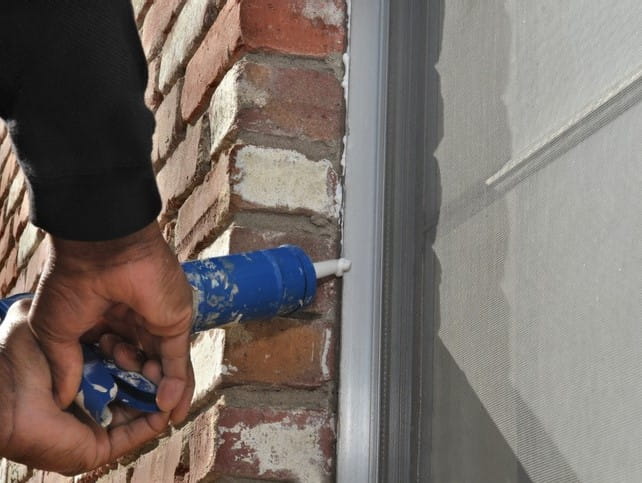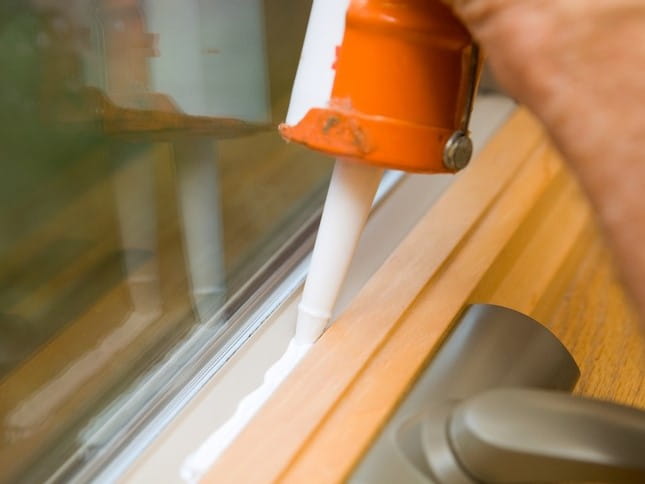What You Need to Know About Caulk

The Bottom Line
There are various kinds of caulking compounds on the market, each geared to a specific kind of project. Most caulks are made up of acrylic, latex, silicone, or a combination of all three. In general, caulk is only a mild irritant.

The Full Story
"Caulk" or "caulking" can refer to the product itself or the process of using it. Caulk was first used in wooden shipbuilding to fill the space between planks of wood in order to make the vessel watertight. Today, it is the chalky or rubbery sealant you see around your home. It is essential for closing off and sealing gaps and cracks around bathtubs, sinks, windows, doors, plumbing, and electrical wiring. Caulk is indispensable in preventing water damage to these structures and lowering your home’s energy costs by keeping cold or hot air out.
There are various kinds of caulking compounds on the market, and each is geared to the specific kind of project. For example, one kind of caulk is appropriate for concrete, brick, or metal surfaces while another kind is better on glass or ceramic tile. Some are more resistant to moisture or temperature extremes than others. Most caulks are made up of acrylic, latex, silicone, or a combination of all three.
Historically, exposure to caulk was associated with potential poisoning because caulking compounds as well as many other construction materials such as adhesives, paints, and sealants, used to contain chemicals called polychlorinated biphenyls (PCBs). PCBs are a group of man-made chemicals with no known natural sources. Once in the environment, PCBs do not break down easily and can remain for very long periods of time. PCBs were banned in the US in 1979 due to scientific evidence of their adverse effects on humans, animals, and the environment. Even though PCBs have been banned here, they are still prevalent throughout the world. There is growing public awareness and concern that caulking compounds and other construction materials in older buildings such as schools could still be important sources of PCB exposure.
The US Environmental Protection Agency has set regulatory requirements for the maximum amount of PCBs allowed in indoor air and has provided guidelines for school administrators and building owners for how to best manage and limit sources of PCBs. These include ventilation, removal of the source when possible, covering the PCB-containing materials with a film or sealant, physical barriers to separate areas with PCB material from other areas of a building, and safe disposal of PCB-containing materials.
The degree of adverse health effects posed by old PCB-containing building materials is not well-known but it is generally considered to be low-level. Fortunately, PCBs in caulk have not been found in single-family homes. Sources of PCBs today are old fluorescent lighting fixtures and electrical devices such as TVs and refrigerators made more than 30 years ago, consuming fish caught in contaminated lakes or rivers, and breathing air near hazardous waste sites or drinking contaminated water near these sites.
The most common caulk-related calls to Poison Control occur when a child or pet gets some caulk in their mouth or on their hands, or when someone working with the product is bothered by the strong odor. Sometimes, people touch the caulk before it has cured and then inadvertently touch their mouth or eyes.
In general, caulk is only a mild irritant. If it has already cured and a child swallows a piece of it, it could pose a choking hazard depending on the size of the piece and might also cause a mild stomach upset. The odor can be irritating. Whether you inhale caulk fumes, get it in your eyes, hands or a little in your mouth, serious adverse effects are not expected.
Remember to keep caulking compounds away from children and pets. Read the manufacturer’s instructions for proper use before working with caulk. Be sure to use caulk in a well-ventilated area. Wash your hands thoroughly after handling caulking compounds. If you get caulk in your eyes, flush gently with room temperature water for at least 15 minutes. If you get caulk on your skin, rinse with water immediately.
If someone has been exposed to caulk, check the webPOISONCONTROL® online tool or call Poison Control at 1-800-222-1222 for help.
Serkalem Mekonnen, RN, BSN, MPH
Certified Specialist in Poison Information
Poisoned?
Call 1-800-222-1222 or
Prevention Tips
- Keep caulking compounds away from children and pets.
- Read and follow the manufacturer’s instructions for proper use when working with caulk.
- Use caulking products in a well-ventilated area.
- Wash your hands thoroughly after handling caulking compounds.
This Really Happened
A man came to an ER and reported that he'd been working with caulk earlier that day and had gotten some on his hands. He hadn't washed his hands well afterward and, when he put his contact lenses in, he developed some eye irritation. Both eyes were red, and his eyelids were a bit swollen. He also had some pain when he opened his eyes.
A nurse in the ER called Poison Control for treatment recommendations. Poison Control investigated the product and determined that the caulk was irritating and that it could cause scratches on the surface of the eye due to its gritty texture.
Fortunately, the eye exam performed in the ER did not show any scratches or other eye injuries. It did, however, show a lot of inflammation and irritation. The man was discharged home with an antibiotic ointment to apply to his eyes for several days.
For More Information
Caulk buying guide [internet]. Mooresville NC: Lowe’s; 2016. [accessed Nov 20, 2016]
References
Poisoned?
Call 1-800-222-1222 or
Prevention Tips
- Keep caulking compounds away from children and pets.
- Read and follow the manufacturer’s instructions for proper use when working with caulk.
- Use caulking products in a well-ventilated area.
- Wash your hands thoroughly after handling caulking compounds.
This Really Happened
A man came to an ER and reported that he'd been working with caulk earlier that day and had gotten some on his hands. He hadn't washed his hands well afterward and, when he put his contact lenses in, he developed some eye irritation. Both eyes were red, and his eyelids were a bit swollen. He also had some pain when he opened his eyes.
A nurse in the ER called Poison Control for treatment recommendations. Poison Control investigated the product and determined that the caulk was irritating and that it could cause scratches on the surface of the eye due to its gritty texture.
Fortunately, the eye exam performed in the ER did not show any scratches or other eye injuries. It did, however, show a lot of inflammation and irritation. The man was discharged home with an antibiotic ointment to apply to his eyes for several days.
